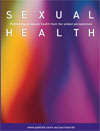
Sexual Health
Volume 14 Number 2 2017
SH16075Self-reported testing and treatment histories among older Australian men and women who may be at risk of a sexually transmissible infection
Rates of sexually transmissible infections (STIs) are increasing among older adults in many countries. Little is known about the testing and treatment histories of these populations. Correlates of testing in the past 5 years among older adults who may be at risk of a STI were examined.
SH16109Daily diary study of adult men’s and women’s event-level sexual motivations and sexual behaviour
Understanding why people have sex has long been of public health and health promotion interest. We used daily diaries to examine how adult men’s and women’s event-specific affective sexual motivations were linked to the types and combinations of sexual behaviours chosen in a given sexual event. Both wanting to have sex, or a partner’s wanting to have sex, were associated with a wider set of behaviours chosen.
SH16143Experience of domestic violence routine screening in Family Planning NSW clinics
This study reviewed implementation of the Domestic Violence Routine Screening (DVRS) program at Family Planning NSW and outcomes of screening to determine the feasibility of routine screening in a family planning setting and the suitability of this program in the context of women’s reproductive and sexual health. A retrospective review of medical records was undertaken of eligible women attending Family Planning NSW clinics in 2015.
SH16091Trends and predictors of recent HIV testing over 22 years among a clinic sample of men who have sex with men in South Australia
A retrospective analysis of computerised medical records of men who have sex with men (MSM) who attended the South Australia Specialist Sexual Health (SASSH) clinic at their first visit was conducted to determine whether HIV testing had changed. The proportion of newly registered MSM who reported ever being tested for HIV declined; the proportion of MSM who returned to the clinic for HIV testing within 12 months did not change, with less than 40% of MSM returning for HIV testing. The findings suggest that HIV testing rate among MSM attending SASSH was suboptimal. New approaches are needed to increase the uptake and early detection of HIV infection among the high-priority MSM population.
SH16100HIV testing self-efficacy is associated with higher HIV testing frequency and perceived likelihood to self-test among gay and bisexual men
An eight-item question block was used to construct a single broad measure capturing confidence in one’s perceived ability to undertake various aspects of HIV testing and self-testing (self-efficacy) among higher risk gay and bisexual men. Higher self-efficacy was independently associated greater likelihood to self-test, and higher self-efficacy, partner numbers, and optimism regarding the effects of HIV treatments on HIV transmission were independently associated with higher frequency of HIV testing in the past year. Improving self-efficacy by enhancing knowledge and experience may lead to higher testing frequency among gay and bisexual men. The self-efficacy measure used in the present study could be useful in identifying men likely to face difficulties with HIV testing and self-testing.
SH16132Comparing non-occupational post-exposure prophylaxis drug regimens for HIV: insights from a linked HIV surveillance system
Data from the Victorian NPEP Service (VNPEPS) was linked with all Victorian HIV notifications to identify HIV seroconversions in NPEP users, and potential NPEP failures. Among MSM who presented to the VNPEPS following receptive anal intercourse with a source of unknown HIV serostatus (RAIU), possible NPEP failure occurred in 13 (0.7%) who were prescribed two drug NPEP and six (2.7%) who were prescribed three drug NPEP (P<0.001). This suggests that two-drug NPEP regimens do not result in excess seroconversions compared with three-drug regimens when used following RAIU.
SH16002Uptake and trends in ordering of funded hepatitis B immunisation for priority populations in Victoria, Australia, 2013–2014
Funded hepatitis B vaccination is provided by the Victorian Department of Health and Human Services to at-risk groups, however uptake and impact have not been measured. Analysis of administrative data indicated that approximately 5700 courses of vaccination have been provided, most commonly to household contacts of people diagnosed with hepatitis B. The findings demonstrate that gaps still exist in the provision of immunisation to those at risk of acquisition, particularly people who inject drugs and people living with hepatitis C.
SH16108Preliminary evidence of HIV seroconversion among HIV-negative men who have sex with men taking non-prescribed antiretroviral medication for HIV prevention in Miami, Florida, USA
This case report presents preliminary data from two men who have sex with men who reported HIV seroconversion while using non-prescribed antiretroviral medication (ARV) for pre-exposure prophylaxis (PrEP). The men reported limited knowledge of PrEP, obtaining non-prescribed ARVs from sex partners, and engaging in multiple HIV transmission risk behaviors. The informal, non-prescribed, and non-medically supervised use of ARVs for HIV prevention may leave men unprotected against HIV transmission.
SH16148Need for more research on and health interventions for transgender people
This study described the distribution of transgender-related research in several databases, finding a low scientific output, especially in low-income developing countries. This is a call for more research and public health interventions for transgender people due this population is growing day by day worldwide.
SH16106Screening and management of risk factors for cardiovascular disease in HIV-positive patients attending an Australian urban sexual health clinic
The medical records of 188 patients attending an inner-city sexual health clinic (SHC) between August 2013 and July 2014 were retrospectively reviewed for cardiovascular risk factors and associated screening and management practices. Cardiovascular risk factors were common among attendees of the SHC, including smoking (38%), hypertension (14%) and dyslipidaemia (11%).



